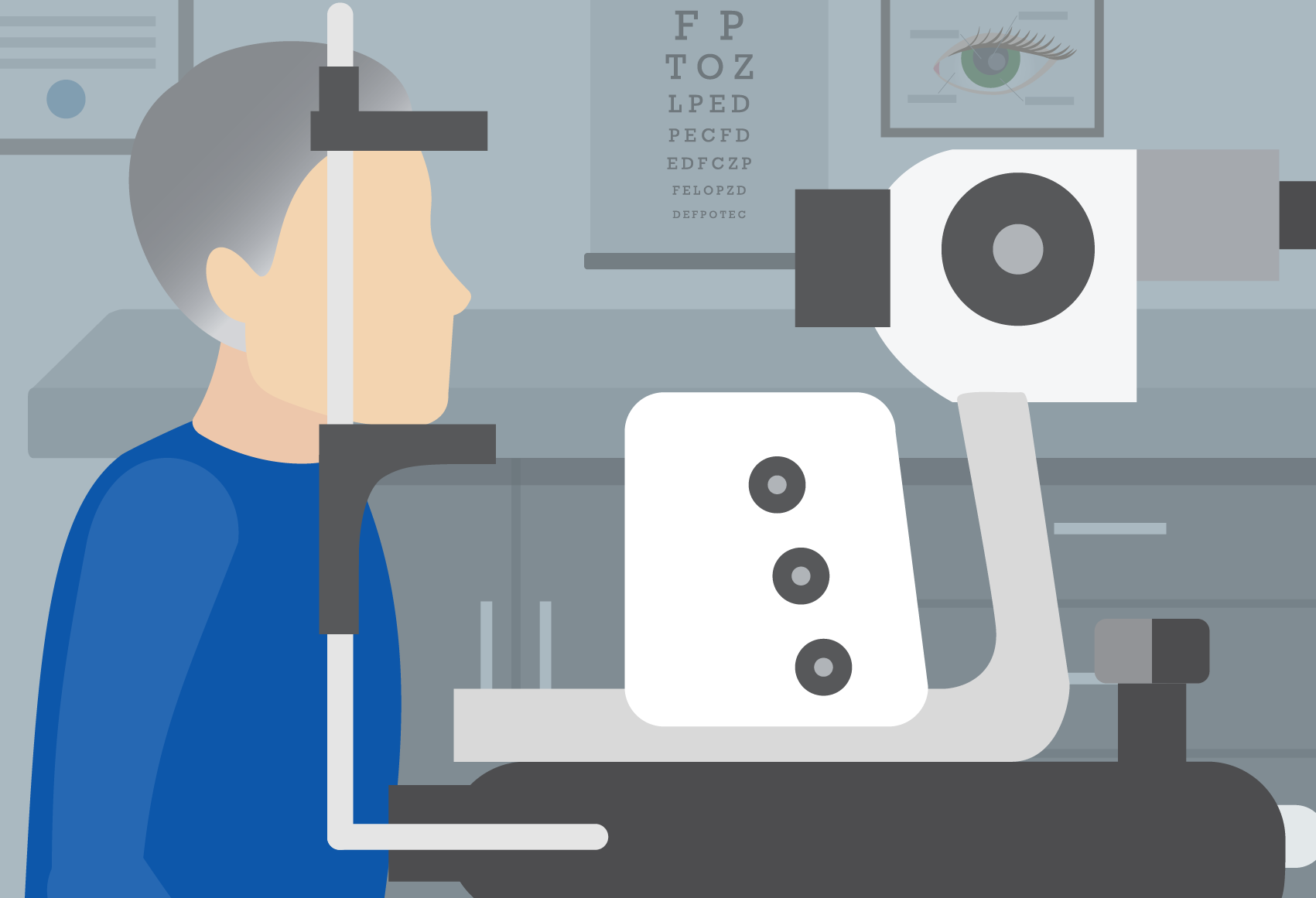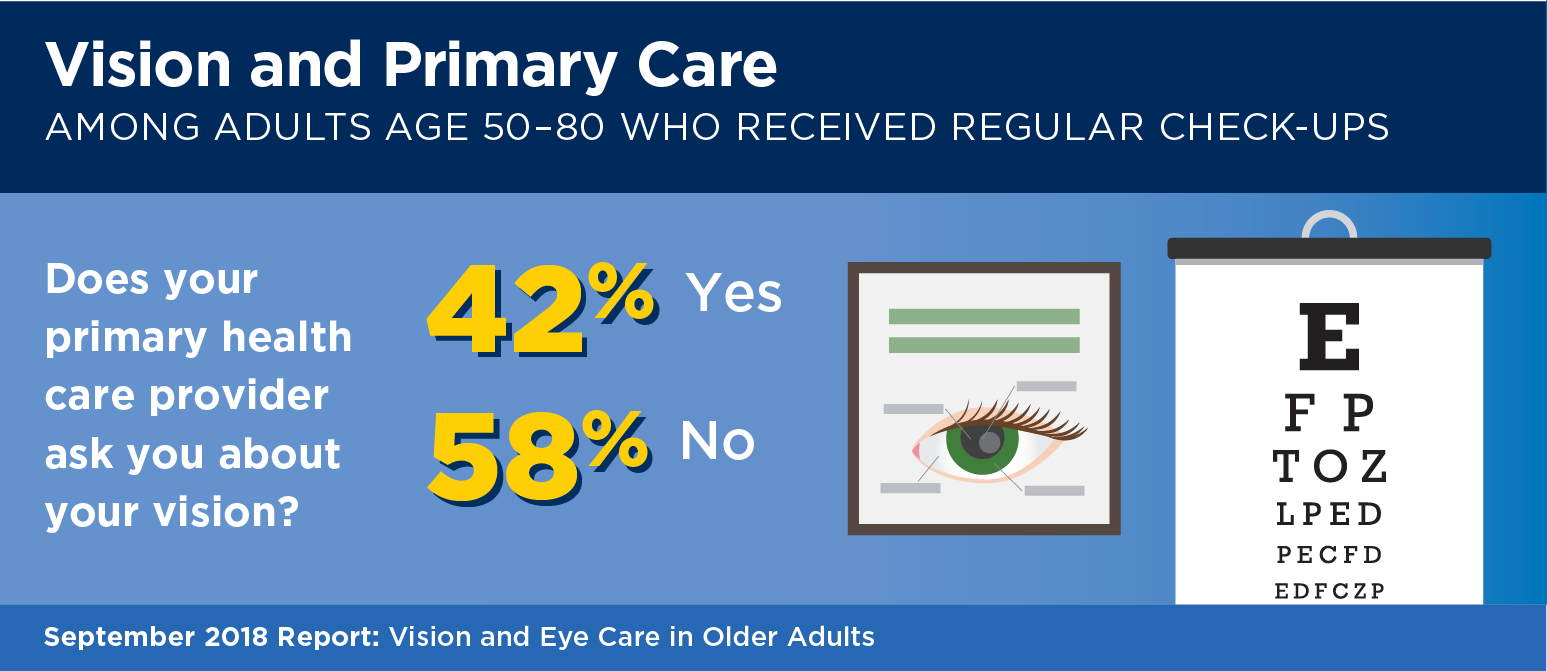
Introduction
Maintaining good vision is an important aspect of overall health. Older adults are at increased risk for age-related eye conditions like cataracts, glaucoma, macular degeneration, and diabetic eye disease. Those with poor vision are also more likely to experience falls, social isolation, and decreased independence.
Many vision problems can be prevented or corrected with proper medical care. However, identifying those who are affected by or at risk for these problems can be challenging. In March 2018, the University of Michigan National Poll on Healthy Aging asked a national sample of adults age 50–80 about their vision and their experiences getting eye care.
Self-Reported Vision and Health
A large majority of respondents (86%) reported wearing glasses and/or contact lenses. The majority felt that their vision (when corrected if they used glasses or contact lenses) was excellent or very good for “seeing things far away” (64%) and “for seeing things up close” (56%). About one in four older adults (27%) reported being diagnosed with cataracts, glaucoma, macular degeneration, or diabetic eye disease. Respondents who reported excellent/very good vision were more likely to report excellent/very good overall physical health than those with worse vision.

Vision and Primary Care
Among respondents who get regular medical check-ups, two out of five (42%) reported that their primary care provider asked about their vision, and about one in seven (17%) reported having their vision checked using an eye chart at a primary care visit. Respondents who reported that their primary care providers talked to them about vision or checked their vision were more likely to also report having had an exam with an eye doctor in the past two years (91% vs. 77%). Those with a history of diabetes were more likely to say that their primary care providers asked about vision, compared to those without diabetes (59% vs 37%). Those with lower household incomes (50% < $30,000 vs 40% ≥ $30,000) or a history of eye disease (49% vs 39%) were also more likely to report their primary care providers asked about their vision.
Eye Care & Exams
Overall, 89% of older adults believed that it was “important for someone like them” to have an eye exam every 1–2 years, and 82% of all respondents reported having their eyes checked by an eye doctor (ophthalmologist or optometrist) during that time. One in ten older adults (10%) believed that it was important for them to get an eye exam every 1–2 years but had not done so in three or more years.
Most respondents got an eye exam either to have their prescription checked (34%), to make sure their vision was okay (30%), or because they were having a problem with their eyes or vision (18%).
Top reasons why respondents had not had an eye exam in three or more years included: had not had any problems with their eyes or vision (42%), did not get around to it (36%), cost (25%), not covered by insurance (23%), and/or that it was easier to buy reading glasses over the counter (23%).
Implications
Vision loss can negatively impact overall health, well-being, and quality of life. Older adults are at higher risk for impaired vision because many eye conditions become more common with age. Yet, most cases of vision loss are avoidable.
Data from the National Poll on Healthy Aging suggest that the majority of older adults are receiving routine eye care. Nonetheless, the nearly one in five older adults who reported that they had not had their eyes examined in three or more years represent millions of individuals nationally, some of whom may be at increased risk for vision problems due to their personal or family medical history. This poll may have underestimated the extent of vision problems and the amount of eye disease in this age group since it could have been difficult for those with poor vision to complete this survey.
Findings from this poll underscore the important role that primary care providers play in promoting eye health. Respondents whose primary care providers talked to them about their vision were more likely to have had a recent eye exam. In addition, those with diabetes, a history of eye disease, or lower household incomes were more likely to have had a conversation about vision with their primary care provider, suggesting that primary care providers may be more likely to discuss eye health with those known to be at high risk for eye conditions.
However, among patients with diabetes who received regular medical check-ups, two in five indicated that their primary care provider did not ask about their vision. Educating patients about the risk of age-related eye diseases and common symptoms may help motivate those who are at risk for vision loss or are experiencing problems to have a discussion with their primary care provider or seek out specialty eye care.
The number of adults with vision impairment and blindness is projected to double over the next three decades, with minority and lower income populations disproportionately affected. Medicare does not provide coverage for routine eye exams for eyeglass or contact lens prescriptions, which could mean that some older adults may delay or avoid regular eye exams due to financial barriers.
As the number of older adults affected by age-related eye diseases increases, primary care and vision providers should seek opportunities to work together to address health disparities, prevent disability, and improve the well-being of their patients.
Data Source and Methods
This National Poll on Healthy Aging report presents findings from a nationally representative household survey conducted exclusively by GfK Custom Research, LLC (GfK), for the University of Michigan’s Institute for Healthcare Policy and Innovation. National Poll on Healthy Aging surveys are conducted using GfK’s KnowledgePanel®, the largest national, probability-based panel in the U.S. Surveys are fielded two to three times a year with a sample of approximately 2,000 KnowledgePanel® members age 50–80.
This survey was administered online in March 2018 to a randomly selected, stratified group of older adults age 50–80 (n=2,013). Respondents were selected from GfK’s web-enabled KnowledgePanel®, which closely resembles the U.S. population.
The sample was subsequently weighted to reflect population figures from the U.S. Census Bureau.
The completion rate was 74% among panel members contacted to participate. The margin of error is ±1 to 2 percentage points for all the question frequencies, and higher among subgroups.
Findings from the National Poll on Healthy Aging do not represent the opinions of the University of Michigan. The University of Michigan reserves all rights over this material.
Read other National Poll on Healthy Aging reports and about the poll's Michigan findings, and learn about the poll methodology.
Citation
Ehrlich J, Singer D, Solway E, Kirch M, Clark S, Malani, P. Vision and eye care in older adults. University of Michigan National Poll on Healthy Aging. September 2018. Available at: http://hdl.handle.net/2027.42/145685
Scholarly Publications
Ehrlich JR, Ndukwe T, Solway E, et al. Self-reported Eye Care Use Among US Adults Aged 50 to 80 Years. JAMA Ophthalmol. 2019;137(9):1061–1066. doi:10.1001/jamaophthalmol.2019.1927